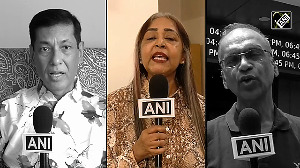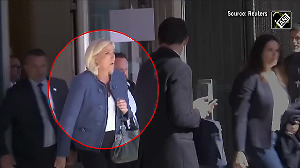Spritual Guru and member of the Shri Amarnath Shrine Board Sri Sri Ravi Shankar has said that he was deeply pained over the toll of casualties during the Sri Amaranth pilgrimage year after year.
"SASB Chairman Governor N N Vohra has done all that he could to make the yatra as smooth as possible. He has taken personal interest and has visited the site, not once or twice, but several times to supervise the efforts," he said.
"Governor Vohra and the chief executive officer of the SASB have been in touch with all the stake holders, including those in Jammu who have been in agitation, and made every effort to keep the fragile peace in the valley. Here, I would wish to also say that Jammu and Kashmir Chief Minister Omar Abdullah and the government machinery have extended all cooperation," he added.
"Media reports and the intellectual bodies are attacking the SASB, presenting an incorrect picture as though the board is not doing anything. While in a democracy, fair criticism or critical assessment of any or all issues is welcome, I would request all concerned with the Yatra to not politicise this matter or question the integrity and sincerity of the board," he said.
"The SASB has made every effort in its capacity. The huge amount of effort that has gone in building more toilets, facilities for hygiene and to take care of the ecology and the environment should not be overlooked," he added.
He makes some observations:
The shortest route for the Holy Cave is through Balta , a treacherous 14-kilometre route, trekking one way. For the pilgrims to return to the base camp, they have to go through several climate zones and cover 28-km in one day.
This is by any standards, too much wear and tear on the human physiology. Only 2 per cent of the youth of this country could pass such a test of endurance. Nearly 6-8 kilometre of the path have neither shelter nor water nor any other medical facilities. The Shrine board neither owns any land or has the funds or the permission for construction or clearance from the forest department.
It is important to note that most of the casualties are below 50 years of age. The slower the movement of the yatris, the greater damage to the environment. The movement of yatris should be made faster and safer.
This can happen if the tracks are widened to 20 feet. Currently, the width is only 3 to 5 feet. To make the yatra faster, we need to reduce the trekking from 14 km to 3 to 5 km. At every kilometer, we need to have a 20,000 sq foot concrete facility that can house rescue and relief operations, restrooms, restaurants and a resting place for yatris. The few doctors who are toiling there have done commendable work. Even their hands are tied due to lack of permanent facilities.
It is imperative that a concrete structure or a structure carved into the rock/hill which can withstand extreme weather conditions and provide better medical facility for the yatris be created. The current facilities are in makeshift tents which cannot provide standard hygienic conditions.
When yatris have to come to the base camp for food, hunger and exhaustion combined with altitude sickness, could cause permanent damage to the internal organs.
The track too should be wide enough for an ambulance to move right up to the foothill of the Holy Shrine. One of the concerns that have been raised often is what would happen to the employment of the khaccharwalas (pony owners) and local labourers. We can definitely employ them in these utility facilities.
I would submit that the trek route that is 14 km be reduced to 4 km, a doable 8 km journey (up and down). There needs to be a facility of 20,000 sq feet which can hold toilets, water and solar electric power. Unlike in the plains, the time window available for the board to work is very short. The board is also planning to have more green energy through solar power panels and drinking water facilities in the coming years. Concrete structures are imperative for these amenities.
There is also a need for a well-equipped hospital at the base camp in Balta. All that we would require is for the forest department to clear this piece of land to build the shelters on the way to the shrine; for the army to widen the tracks; required funds need to be sanctioned either by the State or the Centre.
Regarding educating the Yatris, the board has spread awareness using the media and through educational materials. The board is willing to do even more in this direction in association with the media. Without the lack of permanent structures, we would continue to live in a primitive era of make shift tents and sub standard medical and other facilities.







 © 2025
© 2025